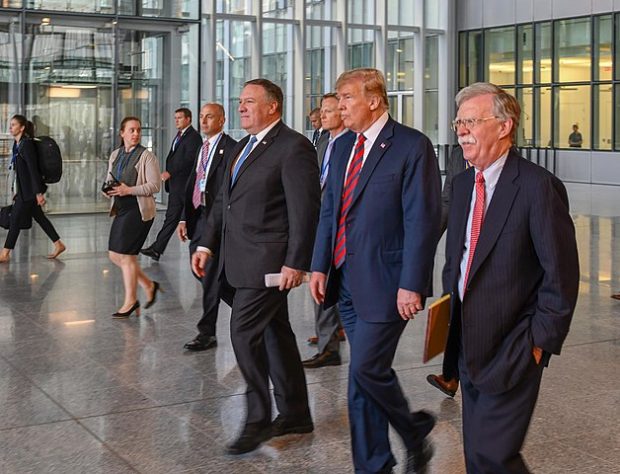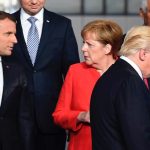by Helena Cobban
In May, President Donald J. Trump rolled out his policy of “maximum pressure” designed to force Tehran to concede to far-reaching demands. He tightened U.S. sanctions against Iran considerably and ordered the USS Abraham Lincoln aircraft carrier and numerous other military units deployed to (or toward) the Persian Gulf. Then—especially after Iran shot down a large U.S. Navy drone in late June—the world braced for a showdown.
It never came.
Non-trivial potential for rapid, perhaps catastrophic, escalation in the Gulf through miscalculation or the malevolent acts of provocateurs still remains. But barring those scenarios, it looks as if the prospects for a Great U.S.-Iran Conflict of Summer 2019, which so many of us feared six weeks ago, have now dissipated. It is worth exploring how and why that happened; and also, what this whole incident tells us about the dynamics of today’s world—and what steps leaders worldwide should take to ensure that another “Great U.S.-Iran Showdown” doesn’t come back to roil the world in another season.
Sometimes, as Sherlock Holmes taught us, you can learn a lot from exploring the story of the dogs that did not bark in the night. The same is true of the Dogs of War in today’s Persian Gulf.
As indicated above, Trump’s “maximum pressure” project relied on applying two primary levers against Iran:
- Speedy strangulation of the country’s economy through sanctions, which he hoped would lead to an explosion of popular Iranian discontent that would put pressure on the country’s leaders to either meet Washington’s demands or be overthrown.
- A credible threat of massively debilitating military strikes, to be conducted by the United States either alone or in conjunction with allies.
Successful use of both these levers needed the active support of other parties. For the sanctions to “work” as designed, Washington needed to be able to cow all other governments to go along with them. It also needed a critical mass of “the Iranian people” to blame all the sanctions-induced belt-tightening on their own rulers, not on Washington. In the case of the military threat, for that to work it needed to engage the active support of as many other militaries as possible—and also, to be “credible” in the sense that the damage threatened to Iran would be massive and unacceptable to Iran’s rulers and people, while any counter-damage suffered by the United States and its allies would fall far below some “acceptable” limit.
The record of the “tight sanctions” lever was mixed, but informative. At the global level, Trump was able to use Washington’s domination of the SWIFT international payments system to cow or force broad swathes of the international community to comply with is new round of anti-Iran sanctions. Attempts by the Europeans to “swiftly” construct an alternative to SWIFT never really gained traction. The Russians and Chinese reportedly had little more success in building the alternative they had proposed—though China has definitely looked as if it was continuing to ship and buy oil from Iran in various ways, and on unknown terms.
Where the tight-sanctions lever seems clearly not to have worked at all is regarding its effects on Iran’s internal politics. This comes as no surprise to anyone who has studied the regime-strengthening effects of tight sanctions in numerous earlier contexts. (But possibly Trump and his advisors had not spent much time pursuing such studies before they rolled out their maximum pressure project.)
The lever of threatening massive military strikes against Iran similarly turned out to be a chimera. Four days after the Iranians shot down the U.S. Reaper Hawk drone that had almost certainly had entered their airspace on June 20, Trump ordered a retaliatory strike on some Iranian radar and missile sites—but then he retracted the order shortly before the strikes were to be launched.
The full story of that retraction has yet to be told. Trump claimed he did it because he had learned the raid could kill up to 150 Iranians, which he judged “disproportionate.” It is also likely that U.S. military leaders, tasked with carrying out his strike order, would have informed the president that killing that many members of the Iranian military would almost certainly have provoked Iranian counter-action—and that the many war-games they had conducted since (and before) 2002, gaming out the possible course of a U.S.-Iran confrontation in the Gulf, had led to dismal final outcomes for the U.S. side.
In the early weeks of Trump’s “maximum pressure” campaign against Iran—and indeed, ever since he took the breathtaking step of taking the United States out of the six-party Joint Comprehensive Plan of Action (JCPOA) with Iran, in May 2018—he and his two in-house hawks, national security advisor John Bolton and Secretary of State Mike Pompeo, heard strong support and encouragement from three Middle Eastern states: Israel, Saudi Arabia, and the United Arab Emirates. But as the maximum pressure campaign progressed through late June and July, the latter two of these potential allies started to edge away from the strongly confrontational stance they had earlier maintained toward Iran. And even Israel’s hawkish prime minister, Binyamin Netanyahu, dialed back considerably from his earlier incitement to ever greater U.S. escalation against Tehran.
As for the Europeans, Pompeo worked pretty hard to persuade several European countries to send a special, “European” anti-Iran maritime force to the Gulf. But that effort came to naught. Most European leaders were still badly piqued that Trump had summarily quit the JCPOA they had worked so hard to achieve—and piqued, too, over several other notable slights he had dealt them since 2017. True, they were not able (or motivated enough) to do anything effective to counter the sanctions part of the anti-Iran policy. But they were also not about to be dragooned into sending any of their national navies into what could well turn out to be a massive maelstrom in the Gulf. Britain’s Boris Johnson was the only “European” leader willing to send a couple of boats to the Gulf, and he reportedly put these under the command of the U.S. naval forces there.
Of the three Middle Eastern states that Trump and Pompeo hoped to enlist into prominent roles in their anti-Iran coalition, the UAE’s reluctance to go along has been, to many, the most surprising. After all, the UAE’s de facto leader, Mohammad bin Zayed (MBZ), had long been a key opponent of the JCPOA and a key instigator of all the moves Trump and his team took to counter (or overthrow) Tehran’s ruling mullahs. MBZ, who is the crown prince of the UAE’s largest and wealthiest emirate, Abu Dhabi, retained numerous former high-level U.S. officials on his payroll. He had long had semi-covert contacts with various Israeli agencies and in 2015 he also, according to several accounts from the region, helped design the path to power taken by his younger and better-known Saudi counterpart, Mohammad bin Salman (MBS).
One of the first projects the two men undertook together, back in March 2015 when MBS was still only the Saudi defense minister and not yet crown prince, was the large-scale attack against the Houthis in Yemen. Significantly, one of the biggest gripes the two princes had against the Houthis was their alleged alliance with Iran. MBS took the lead in that operation, crowing that he expected to win total victory in three weeks. Four and half years later, after the war has killed 90,000 Yemenis and spread cholera, famine, and destruction throughout the country, the Houthis still remain in power in the capital, Sanaa.
The war in Yemen has caused the biggest rift between MBS and MBZ to date. In recent weeks, the UAE announced the withdrawal of its troops from the broad swathes of southern Yemen that they had occupied and more recently, after most of them had withdrawn, their proxies got into numerous battles across southern Yemen with fighters from the Saudi-backed Islah movement.
And meantime, in these past few weeks, both princes have been backpedaling (in MBZ’s case, pretty furiously) from their previous avowals of readiness to fight Iran. A string of great articles in LobeLog has followed these developments. On August 6, Giorgio Cafiero and Khaled al-Jaber tracked a recent thawing of UAE-Iran ties. On August 8, Esfandyar Batmanghalidj noted the crucial role of intra-emirate dynamics, especially the extreme vulnerability of the super-mercantile emirate of Dubai to Iranian investments and other economic influences. On August 13, Paul Pillar assessed “The wisdom of the UAE’s retrenchment.”
If there is a big U.S.-Iran military confrontation in the Gulf, the whole world will face numerous, quite possibly catastrophic strategic uncertainties. But two things are fairly certain. One is that Saudi Arabia and the UAE (along with Qatar and Bahrain, which host sizable US bases, and Oman, which does not) will be on the front lines. The other is that Iran has a network of allies throughout the whole region who will be highly motivated to take action in concert with it. These include not only the Houthis (who are in proven missile-firing distance of several Saudi cities and pipelines), but also the numerous pro-Iranian militias in Iraq (which still hosts some U.S. military forces), the Syrian government (though it may not have much capacity to act), and Hizbullah, right up against Israel’s border with Lebanon.
As long ago as mid-May, soon after Trump’s announcement of “maximum pressure” on Iran, four merchant ships awaiting loading at a UAE oil terminal in the Gulf of Oman were attacked with limpet mines by hands unknown. A month later, a Norwegian tanker and a Japanese tanker, both west of the Strait of Hormuz, suffered strange, small attacks. It is possible that all these attacks were authored by “deniable” Iranian proxies. It is also possible the now very well-funded Iranian opposition group the Mujahedeen-e-Khalq (MEK) or other provocateurs may have launched them. Either way, the implications for the Arab states of the Gulf, all of which are highly dependent on the area’s tight shipping lanes, were almost certainly pretty unsettling. Hizbullah’s ever-feisty head Sayyed Hassan Nasrallah hit the point home hard when he asked in a mid-July interview: “What will be left of the UAE’s glass towers if a war breaks out?”
Nasrallah’s thinly-veiled threat had great credibility. In 2006, when Israel launched a scorched-earth attack against Lebanon in an attempt to destroy Hizbullah, he and his military commanders launched some of their missiles against cities in northern Israel. After 33 days of fierce fighting, the Israelis were forced to withdraw in humiliation. Since then, Hizbullah and Israel have existed alongside each other in a state of highly asymmetrical but definitely reciprocal deterrence. Over in the Gulf region, the missiles that Iran can point at “glass towers” or other targets in the UAE, Saudi Arabia, Bahrain, or Qatar are considerably more sophisticated than those Hizbullah can point at Israel. Earlier this month, four respected experts at the generally hawkish Center for Strategic and International Studies assessed “Iran’s threat to Saudi critical infrastructure” and concluded that: “the Iranian threat remains serious… U.S. policymakers should also proceed cautiously in ways that don’t back Tehran into a corner, such as by threatening the survival of the regime, which might cause Iran to further escalate.”
Viewed from the present perspective (mid-August), it seems that the belligerently anti-Iran words and actions that have come from the White House since early May have backfired, from the point of view of anyone seeking to weaken the mullahs’ hold on power in Tehran or the influence they are able to wield in the region of which they are a part, or seeking to increase the United States’ weight in world politics. Trump, Pompeo, and most especially Bolton all fulminated mightily against Tehran and invested hugely both in making the military preparations needed to be able to threaten Tehran and in trying to pull together a broader global coalition against it.
Fifteen months after Trump roiled the international order by unilaterally (and in a certain sense, illegally) pulling out of the painstakingly negotiated Iran nuclear deal, he has nothing positive to show for having done so. In May, Iran promised that, in response to Trump’s pullout, it would resume the enrichment activities it had earlier (under the JCPOA) agreed to suspend and on August 8, it proceeded to do so—though still under strict IAEA supervision. The mystical alliance of Saudi Arabia, Israel, and the UAE that Trump had hailed as a forceful new presence throughout the Middle East proved itself no more ready to make war against Iran than it was to make peace for Palestine. Europe, which back in May 2018 vowed to do everything it could to save the JCPOA, was reduced to the margins of world affairs. Russia and China, which have their own large challenges in dealing with the U.S. body politic, watch and wait to see what will happen in the Gulf.
There may yet be a military conflagration in the Gulf, though the chances of that diminish by the day. But whether there is one or not, the ugly, bullying way President Trump and his key advisors have dealt with the region has already inflicted deep harm on far too many Iranians (and Yemenis.) It has also considerably weakened Washington’s role in the international system and exacerbated instabilities in that system that will be felt in areas far from the Persian Gulf.






The image chosen by Lobelog for this article is amazing!
What a striking resemblance to Quentin Tarantino’s film poster: Reservoir Dogs (1992)!
Mike, Donald and John, their eyes and body postures seem to have been cut out off that movie!, especially Trump! In fact they more belong to that movie than the actual actors chosen by Tarantino to act as ruthless criminals.
Yes, sometimes fiction imitates life, sometimes ruthless criminals imitate fiction!
It’s surely good to hear from HC again on Iran events. She’s been missed, at least by me. But one minor gentle correction. SWIFT is merely a messaging system, not a money transfer system. SWIFT is easily replaced. Where the US acts is against the actual monetary transfer in which the principals (apparently) can’t be hidden (think NSA). They are then vulnerable to US sanctions.
Regarding military strikes against Iran, as Helena suggests, the Pentagon goes along with every White House order to assault defenseless third-world countries, including Libya most recently, but Iran doesn’t fall into that category. It has many weapons plus Hezbollah’s missiles.
Finally, a weakened US role in the international system is not a bad thing. There may be no more “coalitions of the willing!”
“There may yet be a military conflagration in the Gulf, though the chances of that diminish by the day,“ ended Helena Cobban her good piece. I guess she prepared the article before the release of the Adrian Darya-1 by Gibraltar. As I write this, there is a report that the ship has turned off its automatic identification system, while Greek authorities say that they have not received a request to dock at any of their ports. The US, i.e. JB, has called for the seizure of the ship. The Iranians have responded saying if the US does that there will be ‘heavy consequences’. High adventure in the Mediterranean! That ‘military conflagration’ may be at hand.
While the US demonizes its enemy and exaggerates the enemy’s threat in order to morally justify its own vicious military attacks, the US propaganda apparatus strive to weaken the enemy’s sense of self-certainty by striking fear in its army and population.
1- To its credit the US has succeeded to demonize Iran but profoundly failed to strike fear in its army and people because of our moral superiority and love for our country. Also,
2- The event of 20 June opened Trump’s eyes: he understood Iran is militarily far more advanced than he had been briefed and there would be more embarrassing surprises for the US military if they further challenge our military power. That was the wisest political decision Trump had made in his entire confrontation with Iran.
3- The shooting down of that American Drone also sent the necessary message to the US subservient allies in the region that Iran fears no military challenge, so these allies’ courtiers should think twice before overestimating their shaky political stability under the unstable wings of their American policy makers.
There is no denying that in Iran we have financially and emotionally suffered a lot due to the out of control rise in food prices and medicine, and the ongoing crisis. But we are strong because there are far more values that unite us as a nation than food and medicine.
Although we understand the Western mentality, what we cannot understand how the American people would meet us someday in the future when all these confrontations are over – after such a long performance that is more expected of the barbarians than of a country with over 300 million people that claims to uphold the most noble human values! Our people are suffering because it is hard to get affordable medicine and food and yet you even keep threatening to attack us! Shame on you. How would you one day shake our childrens’ hands in friendship and look into their eyes? you the murderers of their families and loved ones! What is civilisation to you? You who voted for such amoral war mongers!
@KHOSROW,
Well said. Those are very questions that the warmongers have to answer to the children of Iran in the future.
BTW, It’s the second time that The Lobelog has used this picture of the warmongers pretending to be the 3 Musketeers but they’re definitely NOT. Also Trump looks more like a deadman’s walking! Haha!